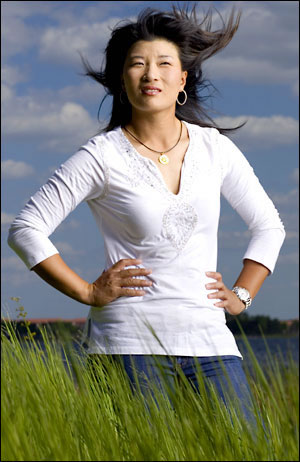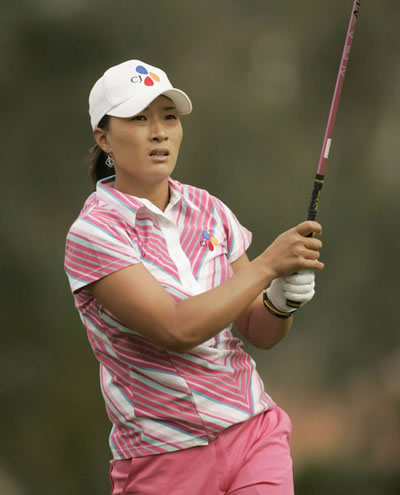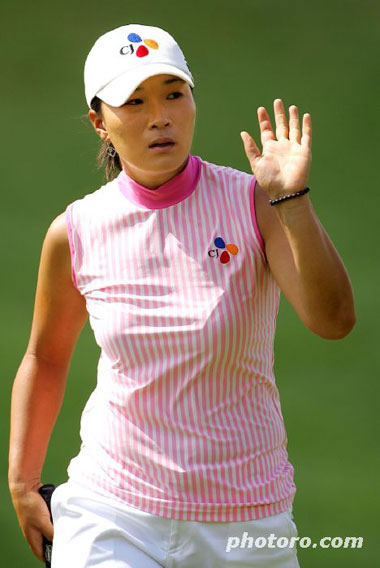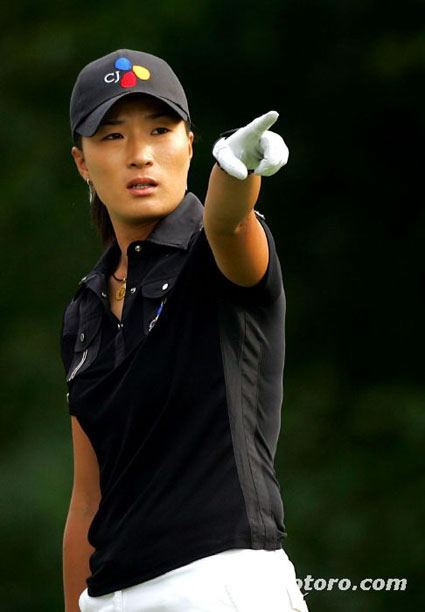 |
 |
 |
 |
 |
 |
2006 McDonald's LPGA Championship:
Long Live the Queen!
 Chapter
Three: Redemption
Chapter
Three: Redemption
During her recovery period, Se Ri had a chance to indulge in some of the
simple pleasures in life she had long denied herself. She later said she
was surprised at how many friends she had once she started calling people
up. She went to movies, restaurants, hung out. She also took up some new
hobbies, such as hiking. When her finger allowed, she also started martial
arts training, learning muay thai kickboxing and taekwando. Most importantly,
she put the clubs away and, for several months, didn't worry about golf.
This was her chance to recharge her batteries and discover just how much
she really wanted to work at her game.
What she discovered in these months was that the old hunger was still burning strong in her. Now refreshed, she was eager to get to work, to see if it was possible for her to climb back to the top. In the two years she had struggled, an entire new group of young stars had taken over the headlines on tour. Included in that bunch were a number of young Koreans, who were winning tournaments at an amazing rate. Since Se Ri had last won on tour, nine different Korean players had notched their first victories, including two Major wins. When Se Ri had last won a Major, she was the only Korean to have done so. Since then, three Koreans (Grace Park, Jeong Jang and her good friend Birdie Kim) had collected Major wins. Se Ri was returning to a league where she would have a big battle to even become the top dog among her countrywomen, much less among all the players. But it was a battle she was itching to join.
Se Ri started her training in earnest in December of 2005, but by then
she had already been intensely working out to strengthen herself. For
the next few months, Se Ri engaged in the kind of intense training you
would expect from her, morning to night, working on getting her game back
into world class shape. Se Ri had several issues that had to be dealt
with. The top one was her driving accuracy: since her slump had started,
her ability to get her tee shots in the fairway had simply disappeared.
In 2005, she was the least accurate driver on the entire tour. There was
no way she would be able to compete until she upped her driving average
significantly.
 After
two months of work, the news out of her training camp was very good indeed.
She told the press early in 2006 that she had fixed her driving problems,
and not only that, but her drives were going ten yards farther than before.
Most promising of all, though, was her attitude. At no point during these
interviews was there any negativity, any of the comments about how she
should do things besides play golf. Clearly, she had gotten the rest she
needed, and was working hard towards her comeback.
After
two months of work, the news out of her training camp was very good indeed.
She told the press early in 2006 that she had fixed her driving problems,
and not only that, but her drives were going ten yards farther than before.
Most promising of all, though, was her attitude. At no point during these
interviews was there any negativity, any of the comments about how she
should do things besides play golf. Clearly, she had gotten the rest she
needed, and was working hard towards her comeback.
Se Ri made her 2006 debut, her first golf tournament since the previous August, at the MasterCard Classic in March. By and large, her first four or five tournaments showed flashes of the old Se Ri from time to time, but she also showed a lot of rust, making a lot of mistakes that she never used to make. Still, there was reason to be hopeful, especially as she was generally hitting the ball much straighter than the last year and a half. Even when she missed a cut, like at the Safeway International, it was by a single shot. This was certainly a step up from the struggles she had endured previously, but she still wasn't producing at anywhere near the level she was capable of.
After she missed the cut at the Takefuji Classic, however, things started
to improve. Although she had to drop out of her next event, the Florida's
Natural, due to a shoulder problem, she was in fact well under the cut
line when she did drop out. At her next event, the Ginn Clubs & Resorts
Open, she stepped it up even further. On a tough, Major caliber track,
she managed two rounds under par, including her first round of the year
in the 60s, and shot no worse than 74 all week. As a result, she recorded
her first top ten since the Jamie Farr Classic in August, 2004: a ninth
place. She wasn't back yet, but the trajectory was positive.
 In
her next three events, she hit double digit fairways almost every round;
she shot only three rounds over par, none more than two over; she managed
her first back to back under par rounds of the year; and saw her scoring
average for the year drop from a high of 73.73 after the Takefuji missed
cut to 72.00 after the ShopRite Classic. Further, at both the Corning
Classic and the ShopRite, she played well enough early on to not only
make the cut with ease, but to also put herself within range of a top
ten. Only an inability to make putts prevented her from getting top tens
at these events. Clearly, she had come a long way in only nine events.
But few were expecting she might have a chance to win the upcoming Major,
even though it was one she had won twice in her career. But Se Ri Pak
has always been about beating the odds. She became a top golfer in her
country when almost no one else from her social background had done it.
She became a top player in the world when no Korean had ever done it.
She became the first Korean to win a Major; the first to qualify for the
Hall of Fame. And now she was determined to show the way again, by overcoming
a slump that might have destroyed a lesser person. With Se Ri, it is always
important to remember the old saying: 'never underestimate the heart of
a champion'.
In
her next three events, she hit double digit fairways almost every round;
she shot only three rounds over par, none more than two over; she managed
her first back to back under par rounds of the year; and saw her scoring
average for the year drop from a high of 73.73 after the Takefuji missed
cut to 72.00 after the ShopRite Classic. Further, at both the Corning
Classic and the ShopRite, she played well enough early on to not only
make the cut with ease, but to also put herself within range of a top
ten. Only an inability to make putts prevented her from getting top tens
at these events. Clearly, she had come a long way in only nine events.
But few were expecting she might have a chance to win the upcoming Major,
even though it was one she had won twice in her career. But Se Ri Pak
has always been about beating the odds. She became a top golfer in her
country when almost no one else from her social background had done it.
She became a top player in the world when no Korean had ever done it.
She became the first Korean to win a Major; the first to qualify for the
Hall of Fame. And now she was determined to show the way again, by overcoming
a slump that might have destroyed a lesser person. With Se Ri, it is always
important to remember the old saying: 'never underestimate the heart of
a champion'.
 Chapter
4: The Heart of a Champion
Chapter
4: The Heart of a Champion
And so, the year's second Major started on June 8th. The course set up
was tough, and the rough would doubtless play a larger factor as the week
progressed, as they did not intend to mow it all weekend. All the top
women from the game were there, including Japanese superstars Ai Miyazato
and Yuri Fudoh; Annika Sorenstam, the three time defending champion, who
was looking to become a four time winner; Karrie Webb, newly resurgent
after her win at the year's first Major; a gaggle of Korean stars, including
white hot Hee-Won Han, Mi Hyun Kim and Seon Hwa Lee; and Michelle Wie,
fresh off her failed attempt to qualify for the men's US Open. These players,
as well as several young Americans, got the lion's share of attention
the first few days. But Se Ri was determined that, by the end, another
name would be on everyone's lips: hers.
The player who surprised everyone on day one, however, was the little known American Nicole Castrale. Castrale had been on the Futures Tour in 2005; her fourth place finish on the money list enabled her to earn an LPGA tour card for the season. She had had a few noteworthy rounds earlier in the year, but nothing she had done prepared everyone for her great opening round here. She shot an 8 under par 64 and took a two shot lead. The course played relatively easy on this day, and many other players also produced sub-par rounds. Cristie Kerr and Pat Hurst, both of whom had been doing quite well in 2006, were tied for second at 6 under. Seon Hwa Lee, fresh off her win at the ShopRite Classic, picked up right where she left off. She shot a 5 under par 67 which consisted of six birdies and but a single bogey. Also shooting a 67 was Christina Kim, who had also had one of her best results of the year at the ShopRite. Several Korean women finished at 4 under, including Hee-Won Han, winner at Corning two weeks previous, and Mi Hyun Kim, who had won at Ginn a few months ago. Jimin Kang shot a 69, but was forced to drop out due to wrist troubles. Shi Hyun Ahn and Young Kim also produced 3 under par rounds on the first day.
 Se
Ri, meanwhile, had an up and down day. Starting on the tenth tee in the
afternoon session, she went out in 2 under par on the back nine. But she
ran into some trouble on the front nine, and quickly made two bogies to
fall back to even. The Se Ri of earlier in the year might have continued
on the bogey train at this point, but Se Ri had already improved to the
point where she was quickly able to reverse the slide. She made birdies
on 6 and 7 to return to 2 under, but ended the day with a bogey on 9 to
fall to one under 71 and a tie for 41st.
Se
Ri, meanwhile, had an up and down day. Starting on the tenth tee in the
afternoon session, she went out in 2 under par on the back nine. But she
ran into some trouble on the front nine, and quickly made two bogies to
fall back to even. The Se Ri of earlier in the year might have continued
on the bogey train at this point, but Se Ri had already improved to the
point where she was quickly able to reverse the slide. She made birdies
on 6 and 7 to return to 2 under, but ended the day with a bogey on 9 to
fall to one under 71 and a tie for 41st.
Not the most promising start, perhaps, but a few things definitely looked
positive. For one, she had hit 10 fairways and 12 greens in regulation,
both very solid numbers. If she could continue with that kind of accuracy
as the rough got tougher throughout the week, she would doubtless advance
up the leaderboard. For another, she had not done anything to shoot herself
out of the tournament. As anyone who watches Majors knows, par can be
your friend, and she actually shot one under par. Thirdly, she was only
7 shots out of the lead, and only five shots out of second. Neither of
those were insurmountable margins. Lastly, she shot the same score as
both Michelle Wie and Annika Sorenstam. One could expect that those two
would make their presence felt later in the week, so Se Ri probably felt
she was in good shape with three rounds to go.